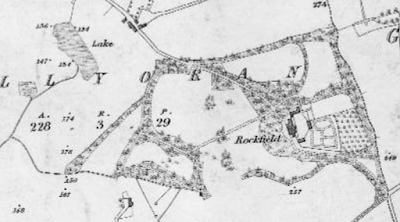 |
| (Image: Timothy Ferres, 2020) |
When I was researching old Dundonald, County Down, in documents and old maps one particular property caught my eye.
Rockfield, 29, Greengraves Road, a few miles outside Dundonald, stands in a rural setting, presently derelict, surrounded by woods.
 |
| (Image: 28DaysLater, 2018) |
This country house has an interesting history.
George Benn, in his History of Belfast, apprises us that the family of McClean, in the middle of the 18th century, was particularly well known in the town.
There were five brothers, all in trade.
 |
| Rockfield House (Image: LambertSmithHampton) |
Adam McClean (c1767-1849), the son of an innkeeper, was a linen merchant and property developer based in High Street, Belfast.
This Adam McClean reputedly built Rockfield House between 1795-1800.
The house, approached by a driveway of several hundred yards, comprises two and a half storeys and five bays.
A single-storey wing has been added to one side of the house, and there is a complex of outbuildings at the rear, where there seems to be a courtyard.
There is a plain Ionic portico at the front entrance, pedimented with a central oculus.
Adam McClean, with his brothers, Samuel and Andrew, had a wine and spirit business in Sugarhouse Entry circa 1800.
 |
| (Image: 28DaysLater, 2018) |
In 1831, he was appointed a committee member of the White Linen Hall.
McClean purchased the land to the rear of the White Linen Hall (now City Hall), between Linenhall Street and the future Great Victoria Street.
McClean’s Fields, as it was called, was a floodplain of the River Blackstaff and hardly any development occurred there until the land was drained in the 1850s.
McClean built a block of houses on Donegall Square South between Adelaide Street and Linenhall Street and Adelaide Street.
He also built numbers 7-11, Wellington Place ca 1830, three four-storey red brick houses (formerly a terrace of six).
 |
| 7-11 Wellington Place, Belfast (Image: Alex. R Hogg, 1931) |
Within three years of Adam McClean's death, in 1852, Rockfield was leased to James Shaw, a Belfast candle and soap manufacturer.
The house was subsequently occupied by Adam S Forster in 1873; and the Symington family in 1876.
Leopold and Helen Greeves lived at Rockfield from about 1909. Leopold's family ran the Conway Mill, and Helen's family owned Marsh's Biscuits.
In the late 1960s Rockfield was acquired by Isaac Agnew, who had established a Belfast motor dealership in 1931.
He died in 1979.
Subsequently Rockfield became a nursing home which, I gather, closed down about 2010.
Rockfield has been for sale since at least July, 2020; according to the estate agent, however, it could be demolished.
It's disappointing that the house could be demolished.
The grounds extend to 46 acres (almost 19 hectares), and offers are invited in the region of £3 million.
The grounds extend to 46 acres (almost 19 hectares), and offers are invited in the region of £3 million.
First published in July, 2020.



6 comments :
Very interesting Tim, thank you
I worked in Rockfield in the 80's as a senior care assistant when the new nursing home had opened. The outhouses at the back had been turned into self contained flats for patients who wanted their independence but used the nursing home for meals and meds. I was sad when it closed it doors as it was such a beautiful place to work in and the scenery was ideal for the residence and patience who needed somewhere peaceful and quiet to enjoy the rest of their lives.
Lynn, thanks so much for your comments. Tim.
It's sad that what is probably one of the last surviving merchant houses of old Belfast faces such an uncertain feature. Adam McClean was a linen draper whose shop stood in High St on the corner of Sugarhouse Entry, now part of the post office. Andrew & Samuel were wine merchants who held the freehold of Sugarhouse entry, so were the landlords of the Dr.Franklin/Peggy Barclays/Bambridge tavern. James & Francis McClean's families had separate apartments on the top floor of the old Banks Buildings.
I have contacted the Ulster Architectural Heritage Society several times over the years hoping to pique their interest in Rockfield, but no luck and living overseas probably doesn't help.
Thank you for your article Tim.
Very interesting article. As a child, my mother knew Helen Greaves as Mr and Mrs Greaves showed dogs as did my grandparents. Mum still has a lovely letter that Helen wrote to her in the early 1950s when mum was in hospital briefly. She still remembers the Greaves arriving at dog shows driven there by their chauffeur!
regards
Chris
I live very close to Rockfield House. There is a Neolithic Portal tomb about 100 meters to the rear of the house. This is known as the Kempe Stones Portal Tomb. There are the remains of Portal Tombs all over the area. The whole area was clearly a very important Neolithic site. I think this is where the name Rockfield House comes from.
Post a Comment